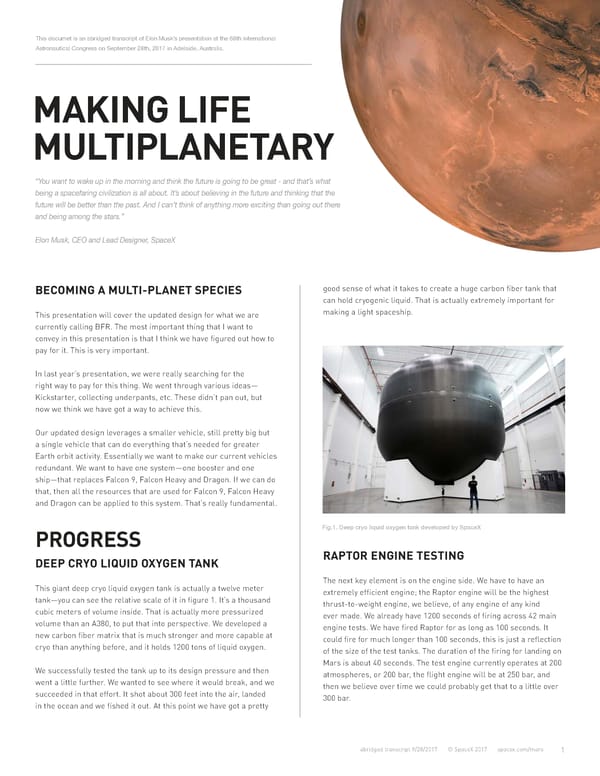Making Life Multiplanetary
Abridged transcript of Elon Musk’s presentation at the 68th International Astronautical Congress
This documet is an abridged transcript of Elon Musk’s presentation at the 68th International Astronautical Congress on September 28th, 2017 in Adelaide, Australia. MAKING LIFE MULTIPLANETARY “You want to wake up in the morning and think the future is going to be great - and that’s what being a spacefaring civilization is all about. It’s about believing in the future and thinking that the future will be better than the past. And I can’t think of anything more exciting than going out there and being among the stars.” Elon Musk, CEO and Lead Designer, SpaceX BECOMING A MULTI-PLANET SPECIES good sense of what it takes to create a huge carbon fiber tank that can hold cryogenic liquid. That is actually extremely important for This presentation will cover the updated design for what we are making a light spaceship. currently calling BFR. The most important thing that I want to convey in this presentation is that I think we have figured out how to pay for it. This is very important. In last year’s presentation, we were really searching for the right way to pay for this thing. We went through various ideas— Kickstarter, collecting underpants, etc. These didn’t pan out, but now we think we have got a way to achieve this. Our updated design leverages a smaller vehicle, still pretty big but a single vehicle that can do everything that’s needed for greater Earth orbit activity. Essentially we want to make our current vehicles redundant. We want to have one system—one booster and one ship—that replaces Falcon 9, Falcon Heavy and Dragon. If we can do that, then all the resources that are used for Falcon 9, Falcon Heavy and Dragon can be applied to this system. That’s really fundamental. PROGRESS Fig.1. Deep cryo liquid oxygen tank developed by SpaceX DEEP CRYO LIQUID OXYGEN TANK RAPTOR ENGINE TESTING The next key element is on the engine side. We have to have an This giant deep cryo liquid oxygen tank is actually a twelve meter extremely efficient engine; the Raptor engine will be the highest tank—you can see the relative scale of it in figure 1. It’s a thousand thrust-to-weight engine, we believe, of any engine of any kind cubic meters of volume inside. That is actually more pressurized ever made. We already have 1200 seconds of firing across 42 main volume than an A380, to put that into perspective. We developed a engine tests. We have fired Raptor for as long as 100 seconds. It new carbon fiber matrix that is much stronger and more capable at could fire for much longer than 100 seconds, this is just a reflection cryo than anything before, and it holds 1200 tons of liquid oxygen. of the size of the test tanks. The duration of the firing for landing on We successfully tested the tank up to its design pressure and then Mars is about 40 seconds. The test engine currently operates at 200 went a little further. We wanted to see where it would break, and we atmospheres, or 200 bar, the flight engine will be at 250 bar, and succeeded in that effort. It shot about 300 feet into the air, landed then we believe over time we could probably get that to a little over in the ocean and we fished it out. At this point we have got a pretty 300 bar. abridged transcript 9/28/2017 © SpaceX 2017 spacex.com/mars 1
 Making Life Multiplanetary Page 2
Making Life Multiplanetary Page 2